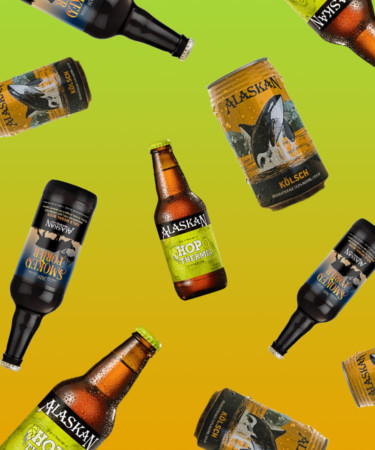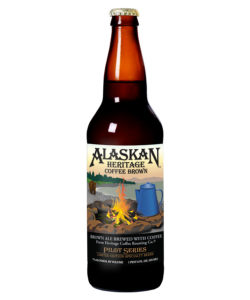Alaska is famous for its breathtaking natural landscape, expansive square footage large enough to fit the state of Texas twice, and must-see Northern Lights. But enough about nature: What about its beer?
While Alaska is not likely to be one of the first places that comes to mind for craft beer, Alaskan Brewing Company has helped put the state on the map for enthusiasts as one of the biggest craft beer producers in the country. The brewery was founded in 1986 by Alaska-loving wife and husband Marcy and Geoff Larson, who also shared a love for homebrewing.
Now, it serves up its signature Amber, a Pale Ale, and IPAs at its brewery and taproom in Juneau and across much of the country.
Here are nine more things you should know about Alaskan Brewing Co.
Yes, the beer really is brewed in Alaska.
Alaskan Brewing Co. is located in the state’s remote capital, Juneau. Surrounded on all sides by the Gulf of Alaska and home to vast areas of wilderness and wildlife, Juneau isn’t an obvious spot for a brewery, but when Marcy and Geoff Larson moved to Alaska from the contiguous U.S. and decided to make a living by making beer, Juneau was where they wanted to be. When the couple opened the brewery’s doors to the public in 1986, it marked the first time a brewery had been established there since Prohibition.
Juneau loves the Larsons back: The city named both Marcy and Geoff citizens of the year in 2020.
The 49th U.S. state is home to the 26th top-producing craft brewery in the nation.
Alaskan Brewing churns out a lot of beer. In 2020, it was the 26th top craft producer by volume in the nation, according to the Brewer’s Association annual report. Plus, it’s the only brewery from Alaska to make the list. Alaskan Brewing is no stranger to high production volume, either, having steadily made it within the top 30 producers on the list for over 10 consecutive years.
Alaskan’s first beer — and its top-selling — was inspired by the Gold Rush.
The Alaskan Amber, a German altbier-style, malty beer that was the company’s first creation, was brewed long before Alaskan Brewing came to be. Before the brewery launched, co-founder Marcy Larson did her background research on the history of Alaskan brewing. As she sifted through old brewing documents, she came across records for Douglas City Brewing Co., an Alaskan brewery that operated from 1899 to 1907. She was fascinated by one brewer’s method of fermenting beer in gold mine shafts to create an amber ale. Her husband, a homebrewer, set out to revamp the recipe by using similar techniques to those described in the old documents (sans gold mine shaft this time).
Today, Alaskan Amber is the best-selling beer on the brewery’s list. Over the years, it has consistently accounted for roughly 50 percent of sales volume, even as the brewery has expanded its options.
It’s the oldest brewery in Alaska and one of the oldest in the U.S.
Alaskan Brewing charted new territory in 1986, when it became the first (and now oldest) post-Prohibition brewery in the state. Over 40 new breweries have followed in its footsteps since then, marking industry growth in Alaska.
Alaskan Brewing is also tied for 16th-oldest brewery in the country. Breweries in New York, Pennsylvania, Wisconsin, and several other states survived Prohibition shutterings. Alaskan Brewing and five other breweries that opened in 1986 were the first to exist in their respective states since the early 1900s.
Sustainability and environmental stewardship are Alaskan priorities.
The conversation surrounding climate change in the beverage alcohol industry is paramount as brewers and winemakers face climate-related challenges. Alaskan Brewing entered the conversation decades ago. This was partly due to necessity, as it was confronted with production and distribution challenges as well as options that could have a large impact, given the brewery’s remote location.
The brewery operates around a central goal of having a zero net negative environmental effect. It achieves this through the use of a carbon dioxide reclamation system. To break it down: Alaskan Brewing’s system captures and cleans the CO2 produced during the brewing process, then reuses it to purge oxygen from holding tanks, as well as during the packaging process. This process alone saves the brewery 45,000 gallons of gas annually and prevents over 1 million pounds of CO2 from entering the atmosphere. The brewery’s mash filter press and spent grain steam boiler also play an important role in reducing oil, water, and malt use and allowing brewers to make the most of all resources.
Transporting Alaskan brews to other states is as hard as it sounds.
Flight or ferry are the only two ways to get to Juneau and Alaskan Brewing’s brick and mortar location. With no roads leading to or from the city nor long flights to other parts of the U.S., getting beer to a broader marketplace is no easy undertaking. Alaskan Brewing currently offers beers in 25 states, including all Western states and much of the Midwest.
When Alaskan Brewing expanded into its most recent states, Hawaii and Utah, it partnered with a new distributor to help make it happen. The cost and transportation challenges in getting the brews to the other side of the country is the reason consumers won’t see Alaskan Brewing distributed on the East Coast.
There’s authentic flavor and flare inside many of the cans…
From label design to the brews themselves, Alaskan Brewing expresses pride in its home state and heritage. “We’re doing the best we can to put Alaska in a bottle,” co-founder Marcy Larson said in a company video. Glacier water from Juneau and spruce tips from Sitka, a nearby town, are ingredients in beers like the Alaskan Winter Ale.
…And the brewery has taken home awards for both.
Spruce IPA, a seasonal brew that features the brewery’s classic Sitka spruce tips that work alongside Citra, Chinook, and Denali hops, won the gold award in the Herb and Spice Beer category at the 2018 World Beer Cup. The win affirmed the brand’s penchant for using natural Alaskan resources in its brews.
In 2021, it took the “Best Can Design” title at the Craft Beer Marketing Awards. The Citrus Wheat beer can — which features a silhouette of a hiker overlooking a mountainous background of green, yellow, and orange — was part of the brewery’s can redesign efforts that pay homage to the nature, wildlife, and activities central to Alaska.
Alaskan Brewing started making seltzers in 2019.
Hard seltzers are a natural extension of brewery capabilities, given that beers and seltzers are brewed and fermented similarly. When Alaskan Brewing launched its own line of hard seltzers in 2019 after a year of recipe development, it made sure to emphasize the Alaskan flavors that set it apart. Like several of its beers, the seltzers are brewed with Sitka spruce tips, which offer notes of citrus and berry in the seltzer.
The uniquely Alaskan seltzers are 4.5 percent alcohol by volume and have just 95 calories per 12-ounce can. They’re currently available in Lemon-Lime, Mango Peach, Mixed Berry, and Cherry Grapefruit flavors.

